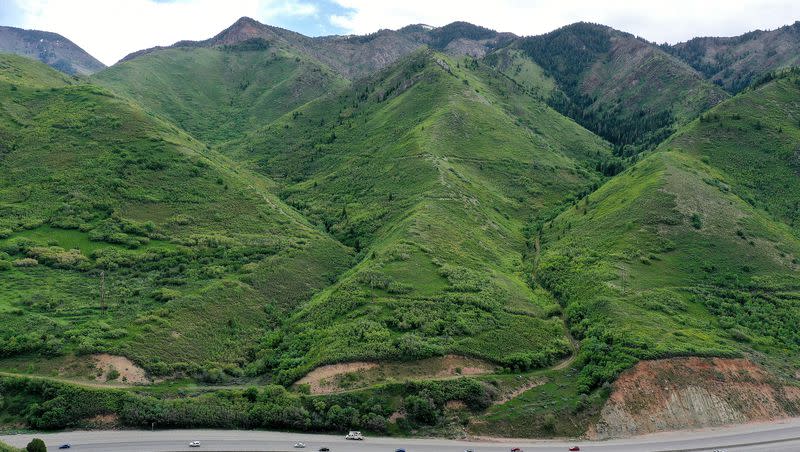Proposed quarry in Parleys Canyon and Utah’s Winter Games leader at odds

The man behind Utah’s efforts to land the Winter Games in 2030 or 2034 said a proposed limestone quarry a few miles east of Salt Lake City up Parleys Canyon belies the state’s efforts to prove itself as a good environmental steward.
“The International Olympic Committee is very focused on preserving our environment, very focused on sustainability, such that our bid has a big part of it around the environment and sustainability,” said Fraser Bullock, president and chief executive officer of the Salt Lake City-Utah Committee for the Games that is behind the bid to host the 2030 or 2034 Winter Games.
“When I look at what we can do in Utah to improve our sustainability or environment, one is things that we can do to proactively improve our air quality and things like adding more electric vehicles,” he said. “But there are also things we can stop from happening in our community.”
The Utah Division of Oil, Gas and Mining approved a permit for a 20-acre privately owned parcel in Parleys Canyon for the future site of a limestone quarry pursued by Granite Construction Co. The land is part of a more than 600-acre parcel opponents believe will lead to a larger quarry phased in over time.
Other permits for the quarry need be granted. A draft document, now under public comment until July 27 by the Utah Division of Air Quality, will look at what dust suppression techniques will be used, how effective they will be at mitigating particulate pollution and what other controls will be in place to minimize impacts from the quarry’s operation, including time of day constraints for operation and the requirement that the road to the site be paved.
Granite Construction, which is seeking to mine the limestone at the quarry, said on its website “misinformation” has been spread about the quarry’s proximity to I-80, how it will “industrialize” a pristine area and be an eyesore for passersby. One would have to take their eyes off the steering wheel and actually look for the quarry, according to the company.
The aggregate produced from the quarry will be used in building of homes and businesses, roadways and more, with Granite saying Utah’s rapid population growth is outpacing available local supplies. It added that all aggregate from the mine will be used east of I-15 in areas like Wasatch County, which has seen its population jump by 48% in the last decade.
“With annual per-capita aggregate demand around 10 tons, the rapidly growing Salt Lake City area will require 258 million tons of various aggregates over the next 20 years,” its website said.
“Because long-term importation of aggregates is not a sustainable practice, materials will need to be transported longer distances, increasing air emissions, road wear, and fuel use. This will make Utah housing and infrastructure less affordable,” it said.
Related
Not here, not now, not ever
SaveParleys.org, a grassroots group organized to stop the quarry, has a litany of reasons why Parleys Canyon and the limestone quarry are an odd couple that don’t belong together.
The organization cites lack of adequate dust control measures outlined in the state’s draft permit, the use of water for dust suppression in a state that has been beleaguered by drought for more than two decades and the overall assertion that Parleys Canyon is simply the wrong place to put in a quarry.
Scott Williams, a member of the group, said Granite is deliberately minimizing the impact the quarry will have on the area with dust, other harmful air pollution, truck traffic and, ultimately, the size of the project.
He said an existing quarry on 10 acres not far from the proposed Granite site already creates issues.
“I’ve driven through there where you can barely see when the wind is blowing and when you’re in Parleys with that wind funnel coming down the canyon, it can get pretty bad.”
Another Save Parleys member said not enough is known about the wind funnels and resulting downwind pollution.
“Utah’s weak regulatory framework makes it highly challenging to mitigate dust pollution at this site,” said Kyle Brennan, an earth science doctoral candidate at the University of Utah. “Before this permit is issued, the unique atmospheric conditions in Parleys Canyon should be studied for at least a full year in order to understand the potential impacts of the quarry on the air quality in downwind communities.”
Related
The group also wants a lawsuit making its way through 3rd District Court to reach a resolution before the state takes any more steps in the limestone quarry permitting process.
A vested mineral right on the property was recorded before Salt Lake County adopted an ordinance to prevent any new mining. The company formed by the property owner, Tree Farm, filed suit against the county after its prohibition was adopted.
Related
Both Williams and Bullock say there are plenty of areas in northern Utah that could support a limestone quarry, but Parleys Canyon is not one of them.
“I wish they would go somewhere else that would not negatively impact our environment,” Bullock said, adding that the canyon, as a corridor to Olympic venues, should not be marred.

